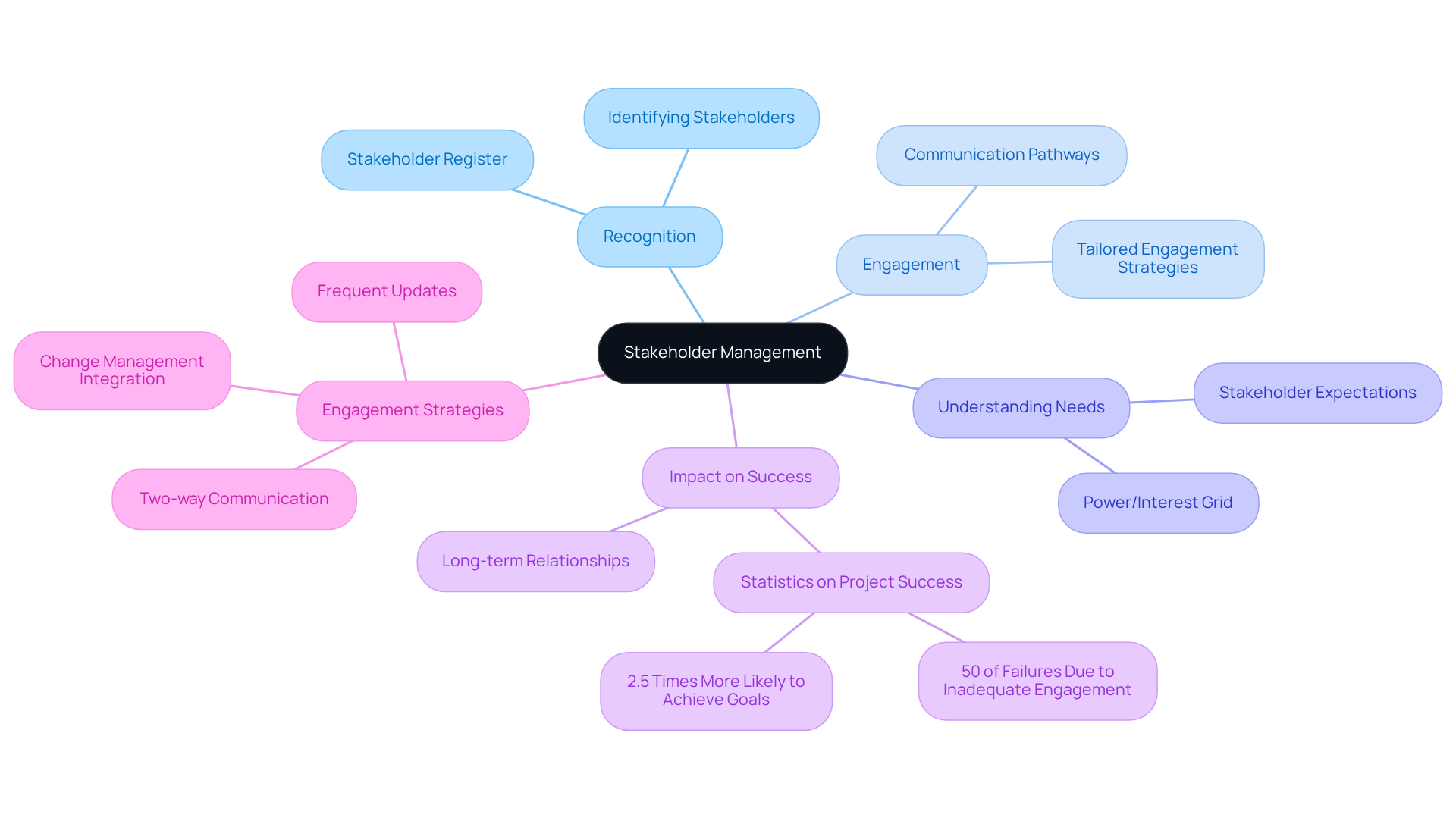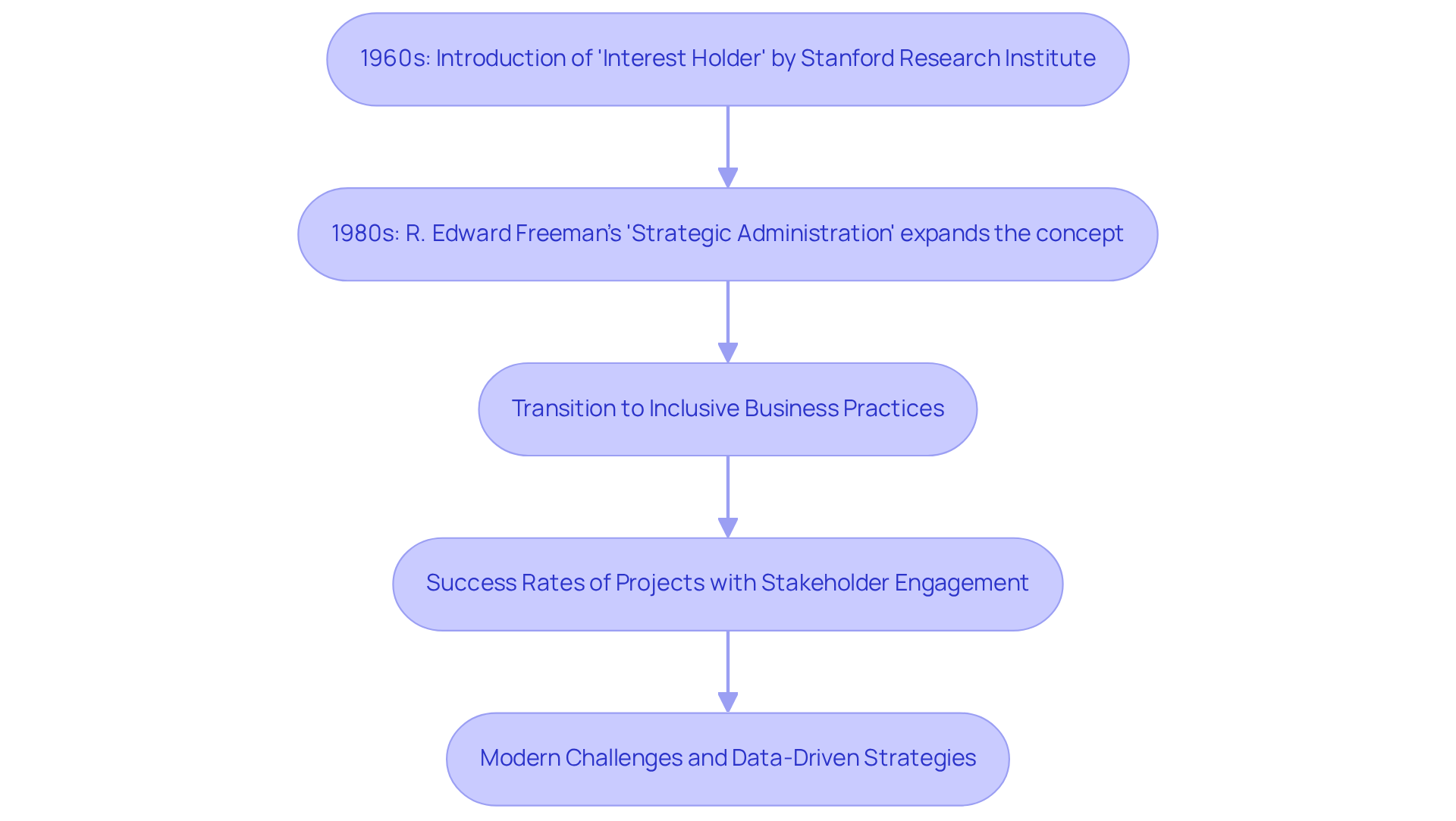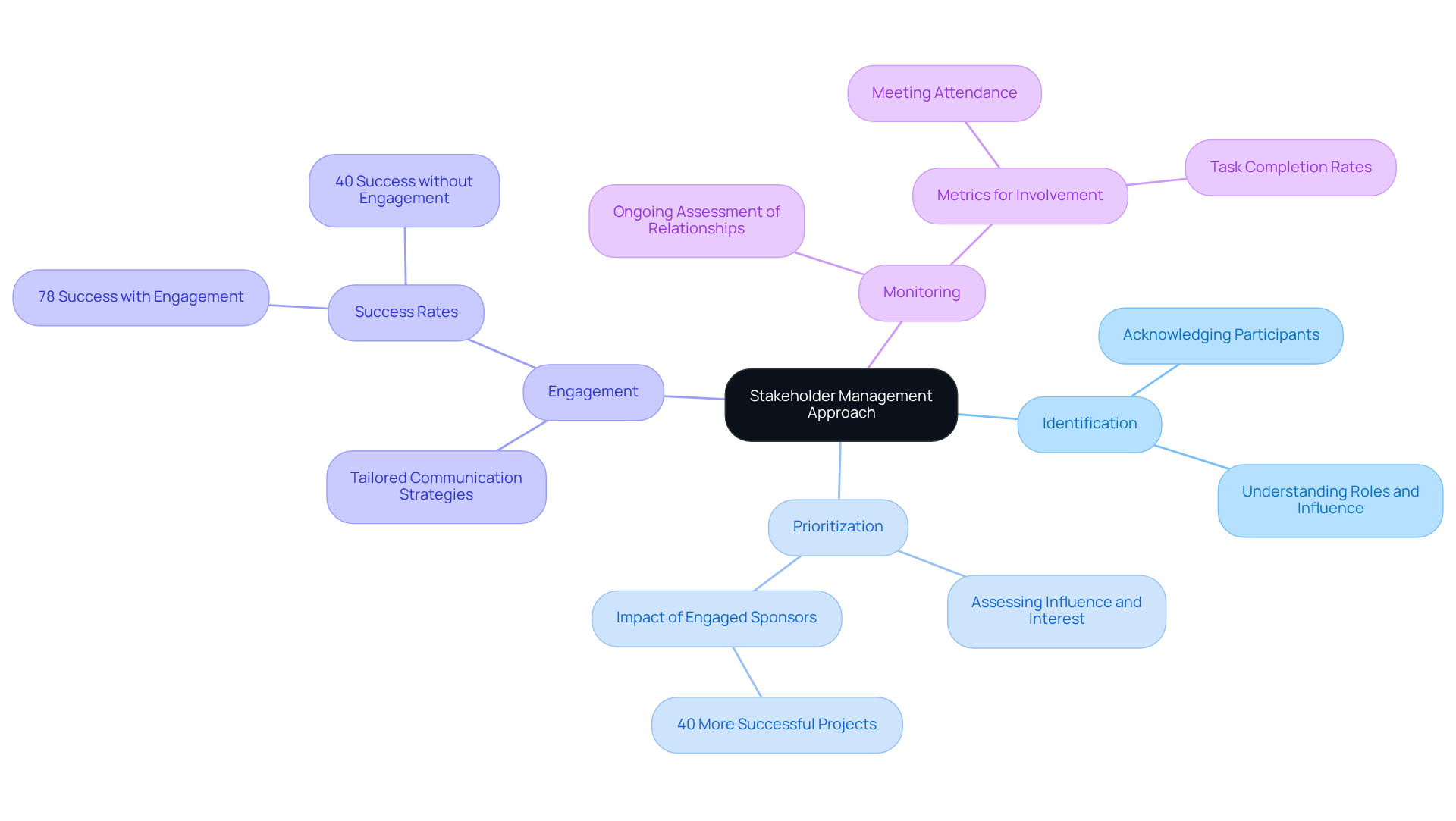Overview
The stakeholder management approach serves as a systematic method for identifying, analyzing, and engaging individuals or groups with a vested interest in an organization. This practice is crucial for the success of various initiatives. Effective stakeholder management not only enhances project success rates but also fosters collaboration and aligns interests. Statistics reveal that initiatives with strong stakeholder involvement achieve a significantly higher success rate compared to those with minimal engagement. Consequently, prioritizing stakeholder engagement is essential for driving successful outcomes.
Introduction
In an increasingly interconnected business environment, the ability to effectively manage stakeholder relationships has become a pivotal factor in determining the success of organizational initiatives. The stakeholder management approach is not merely a strategic tool; it is a comprehensive framework that enables organizations to identify, engage, and align the interests of various parties involved in their operations.
Moreover, with approximately 50% of project failures attributed to insufficient stakeholder involvement, the pressing question arises: how can organizations cultivate meaningful connections that not only enhance project outcomes but also foster long-term sustainability?
Define Stakeholder Management: Core Concepts and Significance
What is the stakeholder management approach? It represents a systematic method of recognizing, examining, and engaging individuals or groups with a vested interest in an initiative or organization. This process involves a thorough understanding of their needs, expectations, and potential impacts on outcomes.
To ensure the smooth execution of initiatives, it is essential to understand what is the stakeholder management approach for effectively managing these stakeholders and cultivating positive relationships while aligning interests. In , understanding what is the stakeholder management approach is crucial, as the influence of various parties can significantly affect the success or failure of initiatives.
Statistics reveal that approximately 50% of initiative failures stem from inadequate participant involvement, underscoring the necessity for organizations to prioritize these connections. Furthermore, understanding what is the stakeholder management approach allows firms to excel in managing relationships with stakeholders, making them 2.5 times more likely to achieve their project goals.
By adopting tailored engagement strategies and conducting comprehensive business assessments, organizations can navigate the complexities of stakeholder relationships, ultimately enhancing their chances of success.
To understand what is the stakeholder management approach, organizations must develop a well-defined participant engagement strategy that outlines communication pathways and the levels of involvement required from each stakeholder, serving as a valuable framework for their engagement efforts. This approach is particularly critical during crises, where temporary leadership can offer direct executive guidance to identify underlying business challenges and initiate transformative change through structured processes such as the Rapid-30.

Trace the Origins of Stakeholder Management: Historical Development and Evolution
The concept of has its roots in the 1960s, marked by the introduction of the term 'interest holder' by the Stanford Research Institute. Initially, this term encompassed those with a vested interest in a business's success, primarily shareholders. However, the scope of oversight expanded significantly during the 1980s, particularly following R. Edward Freeman's seminal work, 'Strategic Administration: A Stakeholder Approach.' This pivotal text underscored the importance of considering all parties involved—employees, customers, suppliers, and the community—in corporate decision-making, highlighting what is the stakeholder management approach.
Over time, understanding what is the stakeholder management approach has emerged as a fundamental aspect of strategic management, reflecting a transition towards more inclusive and responsible business practices. According to a study, projects with robust participant plans achieve an impressive success rate of 83%, highlighting the critical role of effective engagement with stakeholders.
Moreover, as organizations increasingly leverage technology, the methods for involving interested parties have evolved, necessitating a focus on metrics and data-driven strategies. Nonetheless, challenges in engaging executive leadership persist, as their involvement is crucial for aligning interests with organizational goals. This evolution illustrates the interconnectedness of diverse interest groups and their contributions to organizational success, paving the way for more sustainable and ethical business operations.

Identify Key Principles of Stakeholder Management: Framework for Success
Effective management of interested parties is guided by what is the stakeholder management approach, which hinges on several key principles:
- Identification: Acknowledging all participants involved in an initiative or organization is essential. This encompasses grasping their roles and potential influence on results.
- Prioritization: Stakeholders should be assessed based on their influence and interest levels. Organizations with over 80% engaged sponsors report , underscoring the importance of prioritizing essential participants.
- Engagement: Developing tailored communication strategies is crucial for effectively involving interested parties. Projects that implement robust engagement strategies succeed 78% of the time, compared to only 40% for those with less engagement.
- Monitoring: Ongoing assessment of partner relationships enables businesses to adjust their strategies as needed. Metrics such as meeting attendance and task completion rates provide insights into participant involvement.
By adhering to these principles, entities can establish trust, foster collaboration, and significantly enhance outcomes, prompting the question of what is the stakeholder management approach that ultimately leads to improved success rates and satisfaction among involved parties. Notably, 70% of all initiatives fail to deliver what was promised to clients, emphasizing the critical necessity for effective participant involvement.

Examine the Importance of Stakeholder Management: Impact on Business Strategy and Operations
Understanding what is the stakeholder management approach is vital for organizations aiming to enhance their initiative outcomes and overall performance. By proactively addressing participant concerns early in the initiative lifecycle, entities can circumvent potential setbacks and foster a collaborative environment. Integrating diverse perspectives into decision-making processes yields more informed and balanced outcomes, ultimately elevating the quality of decisions made.
Understanding what is the stakeholder management approach is crucial, as strong connections with stakeholders significantly boost the success rates of initiatives. Research indicates that initiatives with robust participant involvement achieve an impressive 70% success rate, compared to those with minimal engagement. Engaged stakeholders are more inclined to support initiatives, provide valuable insights, and positively influence project execution, which raises the question of what is the stakeholder management approach.
Moreover, in today’s business landscape, where corporate social responsibility is increasingly prioritized, effective management of stakeholders promotes transparency and accountability. Organizations that actively engage with their partners are 50% more likely to meet their strategic objectives, underscoring the direct impact of these relationships on organizational success.
For instance, Unilever's Sustainable Living Plan illustrates how broad stakeholder involvement can drive business growth, with brands aligned to the plan expanding at double the rate of their counterparts. Similarly, Interface's commitment to sustainability has resulted in a 96% reduction in greenhouse gas emissions since 1996, demonstrating the financial and ecological benefits of effectively engaging stakeholders.
In conclusion, understanding what is the stakeholder management approach not only enhances project success but also aligns with , ultimately driving long-term value creation.
Conclusion
Understanding the stakeholder management approach is essential for organizations aiming to excel in a competitive landscape. This systematic method empowers businesses to identify, engage, and manage the expectations of those who hold a vested interest in their initiatives. By fostering positive relationships and aligning interests, organizations can significantly increase their chances of success, positioning stakeholder management as a critical component of effective business strategy.
The article elucidates several key concepts, including the historical evolution of stakeholder management, its core principles, and the undeniable impact it has on business operations. From the origins of stakeholder theory in the 1960s to the modern emphasis on inclusive decision-making, organizations that prioritize stakeholder engagement are more likely to achieve their goals. The statistics presented illustrate the substantial benefits of robust participant involvement, affirming that engaged stakeholders can lead to higher success rates and better outcomes.
In light of these insights, it becomes evident that effective stakeholder management is not merely a best practice but a necessity for sustainable business operations. Organizations are encouraged to develop tailored engagement strategies that not only address stakeholder concerns but also integrate diverse perspectives into their decision-making processes. By doing so, they can enhance transparency, accountability, and ultimately drive long-term value creation. Embracing the principles of stakeholder management will not only fortify current initiatives but also pave the way for future successes in an ever-evolving business environment.
Frequently Asked Questions
What is the stakeholder management approach?
The stakeholder management approach is a systematic method of recognizing, examining, and engaging individuals or groups with a vested interest in an initiative or organization. It involves understanding their needs, expectations, and potential impacts on outcomes.
Why is stakeholder management important?
Stakeholder management is crucial because the influence of various parties can significantly affect the success or failure of initiatives. Statistics show that approximately 50% of initiative failures stem from inadequate participant involvement, highlighting the need for organizations to prioritize these connections.
How does effective stakeholder management impact project success?
Organizations that excel in managing relationships with stakeholders are 2.5 times more likely to achieve their project goals. Understanding the stakeholder management approach allows firms to cultivate positive relationships and align interests.
What strategies can organizations adopt for stakeholder engagement?
Organizations can adopt tailored engagement strategies and conduct comprehensive business assessments to navigate the complexities of stakeholder relationships, enhancing their chances of success.
What should a participant engagement strategy include?
A well-defined participant engagement strategy should outline communication pathways and the levels of involvement required from each stakeholder, serving as a valuable framework for engagement efforts.
Why is stakeholder management particularly critical during crises?
During crises, stakeholder management is critical as temporary leadership can provide direct executive guidance to identify underlying business challenges and initiate transformative change through structured processes.




